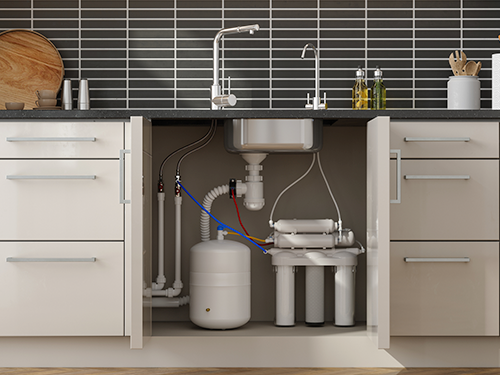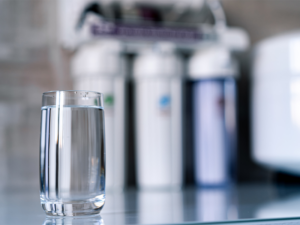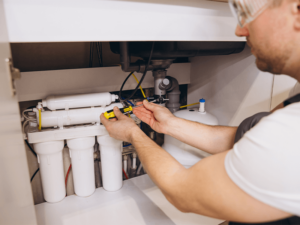
When you fill a glass of water from your kitchen tap, you are trusting that the water is safe for you and your family. But Maryland homeowners are discovering an invisible threat that they need to be concerned about: PFAS, also known as “forever chemicals.” These harmful contaminants have been detected in wells and public water supplies across the state. The good news is that you can take definitive and effective steps to address this concern and protect your health.
At Hague Quality Water of Maryland, we help homeowners across Maryland, D.C., and Delaware identify and eliminate contaminants like PFAS so they can enjoy safe, clean drinking water with confidence. Here’s what you need to know about PFAS — and, more importantly, what you can do to safeguard against them.
What Are PFAS and Why Should Homeowners Be Concerned?
PFAS, or per- and polyfluoroalkyl substances, are synthetic chemicals that have been used for decades in products like nonstick cookware, water-resistant fabrics, food packaging, and firefighting foam. These chemicals are incredibly durable and don’t break down easily — which is why they’re often called “forever chemicals.”
Unfortunately, their persistence means they accumulate in the environment and our bodies. PFAS have contaminated rivers, aquifers, and wells across Maryland, often near military bases, airports, or industrial sites where these chemicals are used heavily.
Studies have linked long-term PFAS exposure to a variety of health risks, including certain cancers, hormone disruption, developmental problems in children, and weakened immune systems. Since PFAS are colorless, odorless, and tasteless, the only way to know if they’re in your water is to test for them.
Three Steps to Address PFAS in Your Tap Water
While hearing that PFAS could be a concern for you and your family might be scary, there are straightforward steps that you can take to identify any water concerns and address them.
Step One: Test Your Water for PFAS
The first and most important step any Maryland homeowner can take is to test their water. Whether you’re on a municipal water supply or a private well, PFAS could be present — and many public water systems in Maryland have detected PFAS at levels above recommended health guidelines. For private well owners, water testing is even more crucial because you are solely responsible for your water quality. Don’t assume your water is safe just because it looks or tastes fine.
Hague Quality Water of Maryland offers professional water testing services designed to detect PFAS and other contaminants. With an accurate test, you’ll have a clear understanding of what’s in your water and whether action is needed. This is the foundation for making informed decisions about treatment.
Step Two: Install the Right Water Treatment System
Once you know PFAS are present, the next step is to remove them. This is where water treatment experts can guide you through selecting the best water filtration system for your home. Since not all filtration systems are created equal, selecting the system that will be the most effective at reducing the PFAS present in your water is of the utmost importance.
Advanced filtration, like that offered by a reverse osmosis filtration system, is highly effective at removing the majority of PFAS from drinking water, with some systems removing up to 99% of the contaminants. Choosing to add this line of defense to your water system is a central step towards protecting your family’s health.
Step Three: Maintain Your Water System Properly
Once you have a water filtration system installed, it is paramount to maintain it so that your water continues to be effectively filtered. The internal components of your system will eventually get clogged up and wear out, but routine maintenance will keep your system working at 100%.
The most basic maintenance will involve changing filters regularly. Most filtration system filters need to be replaced at least twice a year; however, keep in mind that this frequency can vary greatly depending upon your home’s unique needs. Using water frequently or high contaminant levels will clog up filters faster than houses with less demanding filtration needs.
Taking the step to have a filtration system installed is critical — but so is maintaining it. While the system works hard to make your drinking water safe, the internal components eventually become clogged up or wear out. If these issues aren’t addressed, the filtration system will start being less effective.
Other maintenance steps, such as membrane replacement and line flushing are also non-negotiable for keeping your system working properly. Be sure to go over all maintenance requirements and schedules with your technician when you have your new filtration system installed.
Stay Informed About Local Water Quality
Even after you’ve tested and treated your home’s water, it pays to stay informed about changes in your community. Local water quality is not static — PFAS levels can rise or fall based on environmental factors, new industrial activity, or improvements to municipal treatment facilities.
You can monitor public notices from your local water authority or work with us to perform routine retesting of your home’s water. If there are changes to your water quality, we can assess your filtration system to ensure it is still providing you with clean water and consider additional solutions if needed. Staying proactive is the best way to protect yourself from emerging threats like PFAS.
The Benefits of Acting Now
Waiting to address PFAS in your water can have long-term consequences for your family’s health. By testing your water today and installing an appropriate treatment system, you can enjoy peace of mind knowing you’ve taken control of your water quality.
Taking action now also helps protect the value of your home. Buyers are increasingly aware of water quality issues, and having a tested and treated water supply can be a valuable selling point down the line.
Why Professional Expertise Matters
While you may be tempted to run to Walmart and grab a faucet filter or filtered water pitcher, these quick fixes are often not an effective and sustainable solution to PFAS issues. Tackling PFAS contamination for the long term requires professional expertise. A water treatment expert can identify the types of contaminants present in your water, help you select the right equipment, install it properly, and maintain it over time.
Experts, like our technicians at Hague Quality Water of Maryland, bring decades of experience and advanced technology to help homeowners solve even the most complex water challenges. We understand Maryland’s unique water quality issues and are here to guide you every step of the way — from testing and diagnosis to installation and service.
Take Control of Your Water Quality Today
You don’t have to allow PFAS contamination issues to cause you concern. There are concrete steps that you can take to remove PFAS from your drinking water. By testing your water, installing a proven treatment system, and maintaining it properly, you can eliminate “forever chemicals” from your drinking water and finally have peace of mind.
Don’t postpone testing and treating your water just because it tastes fine and you see no concerns. PFAS are invisible to the eye, and their effects on your health can happen over time. Contact us today at Hague Quality Water of Maryland. There is no time better than now to begin the process of ensuring that you and your loved ones have access to clean and safe drinking water.




